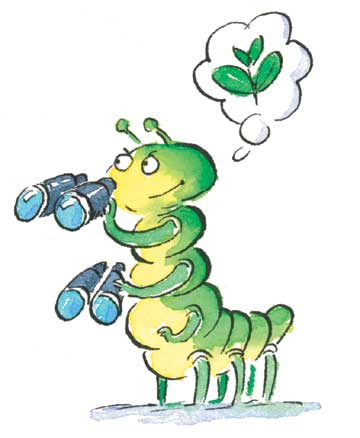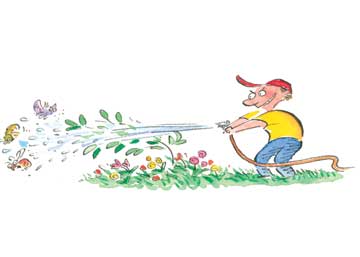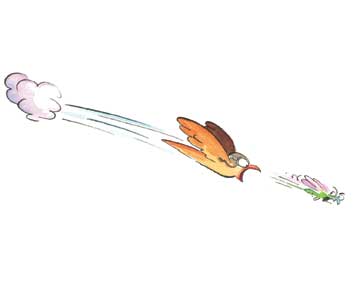





 Check out some old and new ways to get rid of those unwanted tenants.
Check out some old and new ways to get rid of those unwanted tenants.
During these fast-paced, high-tech, ever-changing, over-hyphenated times, it's a comfort to know that some things stay the same. Scientists still struggle to cure the common cold, corn-on-the-cob lovers still struggle to free pieces stuck in their teeth, and gardeners still struggle to control pests. Despite all the technological advances of the past half century, we haven't come very far in the battle against critters.
In April 1944, a Better Homes and Gardens magazine article suggested readers handle moles this way: "You can dig them out if you're patient. And if you are mad enough about what a mole has done to your lawn and flowers, you won't mind in the least giving him the knockout with the flat of your spade. Wait until you see the soil heaving and are sure which way he's headed. Then sock your spade down back of him and give a quick heave."
Crude -- if not downright cruel -- you say? Surely, modern pest-control techniques are more sophisticated and less comic than playing whack-a-mole. Well, fast-forward to the 21st century and the problem of deer in the garden, a result of soaring deer populations and new homes being built in formerly wooded areas. The high-tech solution? Hair. Bags of it, hung in the garden to deter deer. It's a solution offered by many pest-control experts. And cat hair, when applied in and around petunias, scares off rabbits.
The point is that the safest, most effective pest-control methods often have more to do with resourcefulness and persistence, than chemicals, technology, and money. If little has changed over 50 years in the way gardeners deal with pests, it's because there are no quick fixes or magic solutions. The old-fashioned, low-tech ways are still sometimes best. You can't make your garden 100 percent pest proof, but you can take steps to make it a less inviting target. These strategies focus on insect pests, but the same principles can be used to outwit larger, furry critters, as well.
Moles are a truly troublesome yard pest. Click here to learn how to stop them.
continue reading below Keep a look out for pests; and to prevent them from coming, keep your soil healthy.
Keep a look out for pests; and to prevent them from coming, keep your soil healthy.
Experts say healthy soil can prevent about 80 percent of insect damage. Healthy soil breeds healthy plants that are better able to resist pests. Find out what's in your dirt -- besides rocks, rusty nails, old pennies, arrowheads, and that bone your dog forgot about.
Have your soil tested for pH level, essential nutrients, and the presence of organic material. Your local county extension office may offer soil-testing services, or at least be able to refer you to a lab. You can also buy soil-testing kits by mail or from garden centers. The results will indicate what amendments you need to make.
There are thousands of insects in a single square yard of soil. Fortunately, only a small number bother plants. Unfortunately, those that do can breed quickly and do significant damage. The chief enemies are sucking insects, such as aphids and leafhoppers, and chewing insects, such as caterpillars and certain kinds of beetles and worms.
Observe your garden closely to see what insects are present, and learn to tell the good from the bad. An illustrated guide can help you identify insects so you'll know what you're up against.
Learn about common tomato diseases.
Insect pests tend to feed on a plant and then lay their eggs in the soil below. When you plant the same thing in the same spot every year, the emerging larvae have a convenient food supply. However, if you move plants around from year to year, you make it harder for the larvae to find food. Moving a plant even 10 feet helps. That's a big distance to a creature just a fraction of an inch long. Ideally, you shouldn't put annuals or vegetables from the same family in the same location more than once every three to five years.
 Spray only as a last resort.
Spray only as a last resort.
Chemicals should be a last pest-control resort. Many pesticides are harmful to people, and though they do kill pests, they also kill soil nutrients and beneficial insects. If you must spray something on your plants, start with plain water -- it will kill some insects and force off many others. For a little more power, add an insecticidal soap to the water spray. Insecticidal soaps, made from the fatty acids of animals and plants, are both safe and effective in controlling soft-bodied insects.
Some pairs of plants just seem to grow well together, often because one helps repel pests from the other. Employed by gardeners for centuries, this concept is called companion planting. For example, planting onions or sage near carrots helps repel flies that can infest the carrots. Similarly, radishes planted among cucumbers help ward off cucumber beetles. Garden books can help you find good companions for your favorite plants. Certain plants are natural botanical bodyguards, protecting just about anything nearby. Marigolds, for example, boast a natural resistance to harmful nematodes and an odor that turns off pests large and small. Other pest-repelling plants include garlic, lovage, and catnip.
 Birds are on your side when
it comes to fighting pests.
Birds are on your side when
it comes to fighting pests.
You don't have to take on garden pests by yourself. Nature provides an army of allies in the form of predators that feed on insects. Your friends include birds, bees, wasps, and spiders, as well as beneficial insects such as ladybugs, green lacewings, predator mites, mealybug destroyers, ground beetles, and the wickedly named assassin bug.
If buddy bugs are in short supply in your garden, you can buy them -- either by mail or from a garden center -- and store them in the refrigerator until you're ready to release them.
A birdbath and feeder will attract feathered predators to your garden, while nectar-producing flowers will draw beneficial insects. Early bloomers such as pansies and Alyssum are good choices, as are lavender, cosmos, coneflowers, and goldenrod.
Still need more ideas and strategies for dealing with your garden pests? Here are some more tips for eradicating unwanted visitors.
Copyright © www.100flowers.win Botanic Garden All Rights Reserved